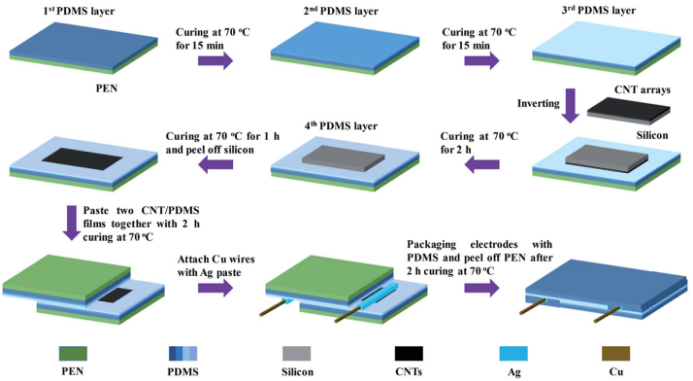5. Wearable Device
5.1 Sensing-range-tunable pressure sensors realized by self-patterned-spacer design and vertical CNT arrays embedded in PDMS 
In the sensors, the two CNT-array layers embedded in PDMS are separated by the proposed self-patterned spacer. With this structure, the realized sensors with large initial resistance designed show tunable response thresholds from 300 Pa to 6.5 kPa while maintaining high sensitivity, which are realized by controlling the spacer thickness and the CNT length. Besides, the vertical CNT arrays have a large specific surface area, which can dramatically change the resistance of the pressure sensors and lead to high sensitivity with nearly 50 kPa-1. Benefiting from the designs of the self-patterned spacer and the advantageous combination of CNTs and PDMS, the pressure sensors also exhibit a rapid response/relaxation time of 24/32 ms, and good long-term stability with durability test over 10 000 loading/unloading cycles. On the other hand, the realized pressure sensors with small initial resistance designed show a typical piezoresistive characteristic. For applications, the pressure sensors with large initial resistance designed are suitable for the anti-noise applications with pressure thresholds to filter unnecessary noise and save power consumption, while the pressure sensors with small initial resistance designed show the capability of detecting mechanical forces and monitoring human physiological signals. Moreover, the self-patterned design and fabrication method of the spacers also show potentials to be applied in the existing works to further enhance or adjust the performance of those pressure sensors, showing great flexibility. This design demonstrates great potentials to be applied in future advanced flexible wearable systems such as health monitoring, human–machine interaction and the Internet of Things.
5.2 Vertical CNT-Ecoflex Nanofins for Highly Linear Broad-Range-Detection Wearable Strain Sensors
A highly linear and broad-range-detection strain sensor by designing a fin-like microstructure, which combines the advantages of vertical carbon nanotubes (CNTs) and Ecoflex. In the proposed structure, most of the vertically grown CNTs are wrapped by polymer to form the CNT–Ecoflex Nanofin (CEN) matrix, while some of the vertical CNTs at the edge of the CEN protrude, like spines on the fin. These exposed CNT spines can effectively improve the sensitivity, especially to small strain. In the CEN structure, the Ecoflex resists the shifting and breaking of CNTs under cyclic strains, which ensures the stretchability and reliability. The unique CEN structure enables the sensor to obtain excellent linearity under the strain range of 0 to 250% and high sensitivities (from 3 to 18) within a wide sensing range (from 0.1% to 500%). Most importantly, the specification of the strain sensors can be tuned by controlling the lengths and densities of CNTs. These virtues endow the sensor with great application prospects in wearable electronics and health monitoring.
